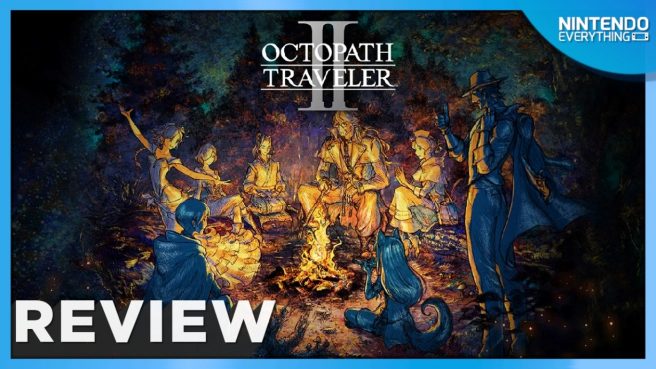System: Switch
Release Date: February 24, 2023
Developer: Square Enix / Acquire
Publisher: Square Enix
The original Octopath Traveler inspired me to create a now sprawling fan group on social media, one that morphed over into a Switch RPG community when the original game’s fire finally died down. Personally, I loved the unique art style the most – beautiful 3D backgrounds and windswept plains, icy tundras and winding cities each punctuated with cute 2D sprites that felt alive in this strangely unique world. Octopath Traveler II is much of the same, but does this entry simply continue with the formula of the first one, or are the changes enough to keep one immersed more than its predecessor?
First off, don’t worry if this is your first introduction to Octopath Traveler. If you haven’t played the first game, there’s no reason to really go back for it. The stories are all different and what little connection there is between games is loose at best. Starting with one of eight playable characters, your first decision is deciding which one to be your “main,” which is a character that won’t be able to be swapped out of your party for a good time. While this decision isn’t super huge, building your party around the chosen character can become a bit of a challenge. Characters that aren’t in the 4-man team don’t get experience points, meaning that the folks you keep with you the most will be overleveled compared to the ones you bench. As much as that can be a bit of a pain, catching up your benched members doesn’t take long in terms of level, its grinding out the Job Points that’s the real chore in playing catch up.
After your initial starter is chosen, you’ll play through their first chapter. This sets the story for the individual character as well as their motivation for traveling the world. I chose the thief, Throné, literally only because I enjoy robbing the world blind. What I was given in her story was a heavy introduction to a woman that was adopted as a child into a crime ring, and one that would see her turned against the same people she grew up alongside as siblings. Surprisingly heavy, the story only deepens as the Mother and Father figures of the clan decided to choose a successor — intending for those successors to battle it out to the death for the chance at becoming the clan’s leader. Throné wants to be free, and her struggle is one that I won’t soon forget.
Upon finishing the first chapter, you gain a lot of freedom – freedom to steal, roam, recruit other party members, and go grind mobs for levels and Job Points to your heart’s content. Job Points accrue slowly, but upon meeting set thresholds, you can redeem them for additional skills and abilities specific to each character’s starting Job. When entering new areas, a disclaimer will appear telling you the combat level of the enemies within: it is crucial to try and meet or exceed that level threshold, or you will have a very bad time even if you’re a seasoned turn-based RPG veteran.
The second character I gunned for was Osvald, a scholar accused of murdering his own wife and daughter. His opening chapters see you escaping a frosty island prison, using your forbidden magic to gain freedom. Osvald’s main motivation is to track down and find the man that actually killed his family. Losing everything has turned him to being hell-bent on seeking revenge. With his strong magic that can hit the entire enemy party, Osvald is a strong contender for hitting elemental weaknesses and exploiting them for massive damage. Paired with Throne’s stealing abilities, you’ll be collecting items and making short work of enemy parties in no time.
After collecting all eight travelers, the time came for me to try and seek out extra jobs. One of the best parts of games like Octopath is the freedom of customizing your characters down to their abilities and skills, Support Skills can be used even without the corresponding class being equipped, and are well worth grinding out for overall party cohesion. Each character can equip up to four Support Skills, so make sure to choose well in order to grind less. Some skills will not affect the party beyond a single application, so be sure to read them closely to avoid wasting a skill slot that could be more beneficial with something else selected.
On the topic of customization, secondary jobs can be equipped by any character as soon as they are unlocked. Like its predecessor, Octopath Traveler II does feature secret jobs that can be sought out along your travels, as well as guilds that feature the 8 main jobs. Guilds are hard to find, but when found will give the player a license for another party member to take on the corresponding job. Two additional licenses can be earned through completing side quests, giving a total of three per job that can be collected. Outfitting your party with additional jobs is a great way to expand not only their available skills and elemental abilities, but the weapons that can be equipped by the character. The more coverage you have in your party, the easier it will be to reduce shield points of enemies and inflict break status to deal massive damage.
A new feature for EX skills has been added, with special shrines hidden across the world that bestow a strong ability on corresponding party members. Visiting these shrines without the specified party member will result in nothing at all happening, but making a note of where these shrines are located and coming back with the party member in tow is better to do sooner rather than later if you’re like me: I tend to forget things. “Out of sight, out of mind,” as they say. With the new EX skills and the day/night path actions, Octopath feels more robust than our last adventure but still falls short in one area that feels crucial to some: party interactivity.
Octopath Traveler II’s separate stories may not encompass friendship and growth between characters and their relationships with one another, but the personal growth aspect is strong. If you were looking for a more traditional telling of eight folks setting out together to complete a common goal, you’ll be disappointed, but with the side chapters that were added, interactivity has improved, but may not be what fans had hoped for. Despite that, the eight stories individually have fantastic writing and growth for each character, and finally will culminate into an endgame that won’t disappoint.
Journeying across Solistia may bring back some great memories if you played the first game. While the areas and cities are different, the exploration and combat remain much the same. Like last time, the music is what really sets this world into motion, specifically for me the town themes really stood out. Standing in Wellgrove on the western continent really feels like a typical forest town in any standard JRPG, but the music is so peppy and uplifting that even though it feels like your standard forest town theme, I can’t get it out of my head. Another wonderful locale to sit and enjoy the ambience are the cobbled streets of Clockbank in the eastern Brightlands, and I’m not just saying this because there’s a cat that you can pet, but I can’t rule out that the cat didn’t add to my joy.
The Verdict

If you want to spend 100 hours traipsing about a beautiful and varied world, you could do far worse than Octopath Traveler II. Catchy town tunes and battle themes (the themes when rare enemies pop up always makes me smile) make this adventure really come alive. As I come to the final chapter and hit the end game, I’m still not able to find some of the secret jobs or the regular Hunter’s Guild, but that just means that my journey won’t truly be over just yet, and that makes me really happy. Eight stories, eight finales, and hours of wonderful gameplay may not give us the interwoven fable that we’ve hoped for, but what’s here is an incredibly improved adventure over our first HD-2D foray, and that’s a pretty successful formula, I guess, because like last time I’m totally hooked.
Octopath Traveler II copy provided by the publisher for the purposes of this review.
